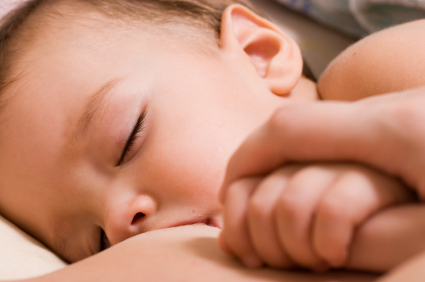Q. Dear Armadillo
I've seen lots of things that talk about ingredients in breastmilk that are not in formula, could you give me some more details please?
Lisa
A. Hi Lisa
I will try! although it's always a difficult one to pitch in terms of how sciency to go - giving enough information without overloading people.
It's quite interesting to talk about constituents because when it comes to research outcome of breast v formula, many will argue "x" wasn't taken into account, or "y" skews the study or suchlike; even if there are numerous studies all indicating a similar outcome, if there's one that isn't as conclusive, people will say "ah but there's conflicting evidence". Looking at
what may cause the different outcome tackles things from another angle - as the question becomes
what is the impact of depriving a child of a particular constituent?
Breastmilk contains around a hundred constituents that cannot be replicated in formula, with more still regularly being found as science advances. What's also worth bearing in mind is that it's not just about each element working alone to influence something specific - many properties can impact in more than one area, and a combination can also work together to affect something else entirely. Furthermore the basic makeup protein, carbs, fat etc are all different because every mammalian milk is
species specific.
As an example the protein in breastmilk does a whole host of things; it contains all required essential amino acids, it provides protective factors (which I will come onto more in a moment) and it carries hormones and vitamins. Protein isn't about obtaining calories for growth, in fact it's a minimal source of energy in breastmilk.
It's also not just about the milk, but the delivery method. Mum creates antibodies specifically tailored to protect against pathogens acquired from her baby’s immediate surroundings. New antibodies are produced whenever she comes in contact with harmful microbes, or when baby breastfeeds, passing into mother’s body via saliva on her nipple. This signals her immune system to provide or produce the antibodies, which are passed back at subsequent feedings. If baby is not breastfeeding, he has only his own very low antibody levels support him; this, compounded by an immature immunological system, make him extremely vulnerable to infection, which can quickly spread.
I will try and cover some of the main constituents we know most about in terms of "defenses against illness/disease".
Interesting Constituents:
αlpha lactalbumin: the main protein in human milk, making up 10-20% of total protein. Perhaps the most exciting discovery of 2010 is that researchers discovered it
causes cell suicide in over forty types of cancer. The team were exploring the antibiotic properties of breast milk when a researcher noticed that cancerous lung cells in a test tube died on contact with breast milk. They discovered that when alphalactalbumin was mixed with acid (as also found in breastmilk and the stomach of breastfed infants) a compound named HAMLET was formed (human alphalactalbumin made lethal to tumour cells) Researchers gave a period of 5 days treatment to patients with bladder cancer and discovered patients urinated dead cancer cells after each treatment. Studies with rats showed that after just seven weeks a highly invasive brain cancer called glioblastoma was seven times smaller in those treated with HAMLET. The most important factor is that the substance has no side effects, it only eliminated cancer and does not harm healthy cells. Karlsson predicted that this therapy would be widely used for adult cancer patients in 5 years. a-lactablumin also binds calcium and zinc, and during digestion forms antibacterial and immunostimulatory properties.
Stem Cells: Have a remarkable ability to develop into many different cell types in the body, serving as a sort of internal repair system. Evidence suggests these cells remain in the body long after cessation of breastfeeding. Stem cells from other sources are already being used to treat leukaemia and could soon help treat eye conditions. Scientists are also researching their potential in the longer term for treating conditions such as spinal injuries, diabetes and Parkinson’s disease.
Lymphocytes: kill infected cells directly or send out chemical messages that mobilise other components of the immune system (see T cells).
T cells: are a sub-group of lymphocytes that play an important role in establishing and maximizing the capabilities of the immune system. These cells are unusual in that cannot kill infected host cells or pathogens, and without other immune cells they would usually be considered useless against an infection. However they have an important role to play activating and directing other immune cells.
Macrophages and
neutrophils: are amongst the most common
leukocytes in human milk, and they surround and destroy harmful bacteria. The macrophages also manufacture
lysozyme, an enzyme that destroys bacteria by disrupting their cell walls. Macrophages in the digestive tract can rally lymphocytes into action against invaders
Immunoglobulins:
IgA,
IgG,
IgM and
IgD are all found in human milk. Of these the most important is IgA, which is both synthesised and stored in the breast. It ‘paints’ baby's tract and gut, covering the mucosal surfaces to prevent the entry of pathogenic bacteria and enteroviruses. It affords protections against E. coli, salmonellae, shigellae, streptococci, staphylococci, pneumococci, poliovirus and the rotaviruses.
Lysozyme: Enhances the ability of IgA and attacks E. coli along with with lactoferrin and sIgA.
Lactoferrin is a protein that binds to iron, preventing disease-causing bacteria from consuming it. It also kills various bacteria including
E coli and also helps prevent the immune system from overreacting. Lactoferrin is currently being investigated as a treatment for auto-immune conditions such as rheumatoid arthritis, multiple sclerosis and septic shock.
Mucin: Attaches to bacteria and viruses that enter the baby’s body. When this happens, other cells in the immune system will destroy the disease-causing substance.
Cytokines are believed to play a significant role in the immune-modulation and immune-protection of breast milk. Most of the cytokines that are known to be deficient in the neonate have been found in significant amounts in breast milk.
Anti-infective factors: During the first 10 days there are more white cells per ml of human milk than there are in blood.
Oligosaccharides: These prebiotic carbohydrate molecules resemble binding sites for bacteria, then attach to it to form a compound that the baby excretes - carrying it out of the body. They influence the microflora producing increased proliferation of probiotics, which defend against pathogens that cause otitis media, respiratory tract infections, urinary tract infections and diarrhoea.
Milk lipids (fats): Milk lipids damage the outer surface of certain types of viruses. When the viruses are damaged, they are unable to replicate and cause an infection in the baby.
Linoleic acid: Associated with anti-cancer properties, can reduce the risk for cardiovascular disease and help fight inflammation.
Anti-secretory factor: protects the infant against diarrhoea.
IL-7: is linked to the
size of the thymus, the central organ in the immune system. It has been found to be up to half the normal size in artificially-fed infants. IL-7 also has an important role in promoting the production of B lymphocytes, the antibody producing cells.
Growth factors: including epidermal, insulin-like and transforming growth factor; these promote gastrointestinal maturation in the infant. Epidermal growth factor leves are highest in the milk of mums who have premature infants, which dramatically reduces the rate of necrotising enterocolitis (NEC) & intestinal inflammation. There is also theory these factors may play a role in "early life programming" which suggests that the adult individual's physiology (eg obesity) and potential morbidity (eg cancer) is predetermined early in life.
This list is by no means exhaustive;
Breastmilk contains a myriad of other factors that work to protect and enhance the development of the breastfed child. These include:
- nucleotides
- defensins
- hormones
- anti-inflammatory components
- soluble CD14 and soluble Toll-like Receptor (health-e-learning)
What is interesting is that as we are discovering more about what the constituents do, it supports what research has been highlighting in terms of outcome. Studies have long linked not breastfeeding with higher rates of ear infections, cancers, diabetes, meningitis, respiratory illness, rheumatoid arthritis (and other diseases of the immune system) gatrointestinal illness and NEC to name just a few from a long list. As we begin to understand more about which part of breastmilk does what, it gives more understanding as to why non breastfed infants are more susceptible - not just as infants but in terms of life long health. What's perhaps the most worrying is that science has hardly scraped the surface yet and so potentially massess of other diseases could also be intricately linked eg researchers are currently exploring links with a number of conditions including multiple sclerosis and chronic fatigue syndrome.
Full list of what's in Breastmilk V Formula
BREASTMILK - bear in mind some are plural and that new constituents are still being identified and their function understood within breastmilk
Water
Carbohydrates (energy source)
Lactose
Oligosaccharides (see below)
Carboxylic acid
Alpha hydroxy acid
Lactic acid
Proteins (building muscles and bones)
Whey protein
Alpha-lactalbumin
HAMLET (Human Alpha-lactalbumin Made Lethal to Tumour cells)
Lactoferrin
Many antimicrobial factors (see below)
Casein
Serum albumin
Non-protein nitrogens
Creatine
Creatinine
Urea
Uric acid
Peptides (see below)
Amino Acids (the building blocks of proteins)
Alanine
Arginine
Aspartate
Clycine
Cystine
Glutamate
Histidine
Isoleucine
Leucine
Lycine
Methionine
Phenylalanine
Proline
Serine
Taurine
Theronine
Tryptophan
Tyrosine
Valine
Carnitine (amino acid compound necessary to make use of fatty acids as an energy source)
Nucleotides (chemical compounds that are the structural units of RNA and DNA)
5’-Adenosine monophosphate (5”-AMP)
3’:5’-Cyclic adenosine monophosphate (3’:5’-cyclic AMP)
5’-Cytidine monophosphate (5’-CMP)
Cytidine diphosphate choline (CDP choline)
Guanosine diphosphate (UDP)
Guanosine diphosphate - mannose
3’- Uridine monophosphate (3’-UMP)
5’-Uridine monophosphate (5’-UMP)
Uridine diphosphate (UDP)
Uridine diphosphate hexose (UDPH)
Uridine diphosphate-N-acetyl-hexosamine (UDPAH)
Uridine diphosphoglucuronic acid (UDPGA)
Several more novel nucleotides of the UDP type
Fats
Triglycerides
Long-chain polyunsaturated fatty acids
Docosahexaenoic acid (DHA) (important for brain development)
Arachidonic acid (AHA) (important for brain development)
Linoleic acid
Alpha-linolenic acid (ALA)
Eicosapentaenoic acid (EPA)
Conjugated linoleic acid (Rumenic acid)
Free Fatty Acids
Monounsaturated fatty acids
Oleic acid
Palmitoleic acid
Heptadecenoic acid
Saturated fatty acids
Stearic
Palmitic acid
Lauric acid
Myristic acid
Phospholipids
Phosphatidylcholine
Phosphatidylethanolamine
Phosphatidylinositol
Lysophosphatidylcholine
Lysophosphatidylethanolamine
Plasmalogens
Sphingolipids
Sphingomyelin
Gangliosides
GM1
GM2
GM3
Glucosylceramide
Glycosphingolipids
Galactosylceramide
Lactosylceramide
Globotriaosylceramide (GB3)
Globoside (GB4)
Sterols
Squalene
Lanosterol
Dimethylsterol
Methosterol
Lathosterol
Desmosterol
Triacylglycerol
Cholesterol
7-dehydrocholesterol
Stigma-and campesterol
7-ketocholesterol
Sitosterol
β-lathosterol
Vitamin D metabolites
Steroid hormones
Vitamins
Vitamin A
Beta carotene
Vitamin B6
Vitamin B8 (Inositol)
Vitamin B12
Vitamin C
Vitamin D
Vitamin E
a-Tocopherol
Vitamin K
Thiamine
Riboflavin
Niacin
Folic acid
Pantothenic acid
Biotin
Minerals
Calcium
Sodium
Potassium
Iron
Zinc
Chloride
Phosphorus
Magnesium
Copper
Manganese
Iodine
Selenium
Choline
Sulpher
Chromium
Cobalt
Fluorine
Nickel
Metal
Molybdenum (essential element in many enzymes)
Growth Factors (aid in the maturation of the intestinal lining)
Cytokines
interleukin-1β (IL-1β)
IL-2
IL-4
IL-6
IL-8
IL-10
Granulocyte-colony stimulating factor (G-CSF)
Macrophage-colony stimulating factor (M-CSF)
Platelet derived growth factors (PDGF)
Vascular endothelial growth factor (VEGF)
Hepatocyte growth factor -α (HGF-α)
HGF-β
Tumor necrosis factor-α
Interferon-γ
Epithelial growth factor (EGF)
Transforming growth factor-α (TGF-α)
TGF β1
TGF-β2
Insulin-like growth factor-I (IGF-I) (also known as somatomedin C)
Insulin-like growth factor- II
Nerve growth factor (NGF)
Erythropoietin
Peptides (combinations of amino acids)
HMGF I (Human growth factor)
HMGF II
HMGF III
Cholecystokinin (CCK)
β-endorphins
Parathyroid hormone (PTH)
Parathyroid hormone-related peptide (PTHrP)
β-defensin-1
Calcitonin
Gastrin
Motilin
Bombesin (gastric releasing peptide, also known as neuromedin B)
Neurotensin
Somatostatin
Hormones (chemical messengers that carry signals from one cell, or group of cells, to another via the blood)
Cortisol
Triiodothyronine (T3)
Thyroxine (T4)
Thyroid stimulating hormone (TSH) (also known as thyrotropin)
Thyroid releasing hormone (TRH)
Prolactin
Oxytocin
Insulin
Corticosterone
Thrombopoietin
Gonadotropin-releasing hormone (GnRH)
GRH
Leptin (aids in regulation of food intake)
Ghrelin (aids in regulation of food intake)
Adiponectin
Feedback inhibitor of lactation (FIL)
Eicosanoids
Prostaglandins (enzymatically derived from fatty acids)
PG-E1
PG-E2
PG-F2
Leukotrienes
Thromboxanes
Prostacyclins
Enzymes (catalysts that support chemical reactions in the body)
Amylase
Arysulfatase
Catalase
Histaminase
Lipase
Lysozyme
PAF-acetylhydrolase
Phosphatase
Xanthine oxidase
Antiproteases (thought to bind themselves to macromolecules such as enzymes and as a result prevent allergic and anaphylactic reactions)
a-1-antitrypsin
a-1-antichymotrypsin
Antimicrobial factors (are used by the immune system to identify and neutralize foreign objects, such as bacteria and viruses.
Leukocytes (white blood cells)
Phagocytes
Basophils
Neutrophils
Eoisinophils
Macrophages
Lymphocytes
B lymphocytes (also known as B cells)
T lymphocytes (also known as C cells)
sIgA (Secretory immunoglobulin A) (the most important antiinfective factor)
IgA2
IgG
IgD
IgM
IgE
Complement C1
Complement C2
Complement C3
Complement C4
Complement C5
Complement C6
Complement C7
Complement C8
Complement C9
Glycoproteins
Mucins (attaches to bacteria and viruses to prevent them from clinging to mucousal tissues)
Lactadherin
Alpha-lactoglobulin
Alpha-2 macroglobulin
Lewis antigens
Ribonuclease
Haemagglutinin inhibitors
Bifidus Factor (increases growth of Lactobacillus bifidus - which is a good bacteria)
Lactoferrin (binds to iron which prevents harmful bacteria from using the iron to grow)
Lactoperoxidase
B12 binding protein (deprives microorganisms of vitamin B12)
Fibronectin (makes phagocytes more aggressive, minimizes inflammation, and repairs damage caused by inflammation)
Oligosaccharides (more than 200 different kinds!)
FORMULA
Water
Carbohydrates
Lactose
Corn maltodextrin
Protein
Partially hydrolyzed reduced minerals whey protein concentrate (from cow’s milk)
Fats
Palm olein
Soybean oil
Coconut oil
High oleic safflower oil (or sunflower oil)
M. alpina oil (Fungal DHA)
C.cohnii oil (Algal ARA)
Minerals
Potassium citrate
Potassium phosphate
Calcium chloride
Tricalcium phosphate
Sodium citrate
Magnesium chloride
Ferrous sulphate
Zinc sulphate
Sodium chloride
Copper sulphate
Potassium iodide
Manganese sulphate
Sodium selenate
Vitamins
Sodium ascorbate
Inositol
Choline bitartrate
Alpha-Tocopheryl acetate
Niacinamide
Calcium pantothenate
Riboflavin
Vitamin A acetate
Pyridoxine hydrochloride
Thiamine mononitrate
Folic acid
Phylloquinone
Biotin
Vitamin D3
Vitamin B12
Enzyme
Trypsin
Amino acid
Taurine
L-Carnitine (a combination of two different amino acids)
Nucleotides
Cytidine 5-monophosphate
Disodium uridine 5-monophosphate
Adenosine 5-monophosphate
Disodium guanosine 5-monophosphate
Soy Lecithin













